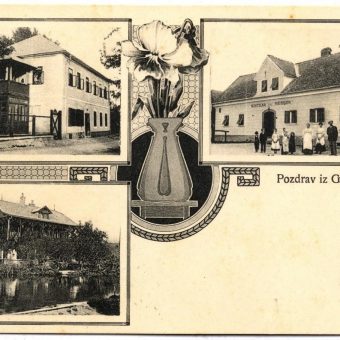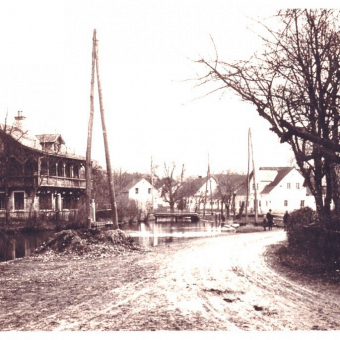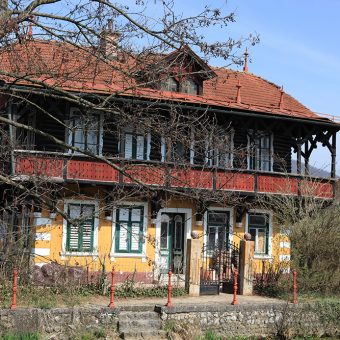Russian Dacha and its history
A review of the archival documents shows that the plot of land on which Russian Dacha stands today was first entered in the land register in 1879. In the same year, Blaž Černe became its owner, building the original house between 1880 and 1882. In 1882, the house was assigned an address, Zgornje Gameljne 35. Blaž Černe and his wife, Marjana Kosmač, had three sons: Franc, Andrej, and Blaž. The older two sons were born in Zgornje Gameljne 6; however, the youngest, Blaž, was born in the new house in Zgornje Gameljne 35. Their father Blaž died shortly after the birth of his third son.
In 1907, the Černe family sold the house to Franc Petrič, a merchant and brewery representative from Ljubljana. In 1908, Franc Petrič rebuilt the house in a style reminiscent of Russian Dacha, as we know today. It was named ‘Villa Petrič’ after him at the time. He was married to a woman from Ljubljana, Marija Več and they had four children together: daughters Marija and Anica, and sons Franc and Milan Henrik. During World War I, Petrič was accused of espionage for the Italians and all his property was seized. The court of the Fifth Armament Stage Command found him guilty and sentenced him to death by hanging, which was later changed to death by shooting. Franc Petrič was thus shot dead on 2 November 1915, at the Suhi bajar military shooting range in Ljubljana. On 17 December 1919, the family dug up the body, which is now buried at Sv. Križ in Ljubljana. His reputation was also rehabilitated at the time.
The postcards of Gameljne from 1910 on the left also show Russian Dacha.
Russian Dacha was at its most beautiful and most glorious period in 1908. That is why the current owner has decided to restore the suburban villa to reflect that particular time. The villa is thus furnished with antiques and artworks that date back to the turn of the century. Everything, even the smallest details, dates back to that time. It offers visitors an experience of the time, both historical as well as artistic and culinary.
After World War I, Villa Petrič was sold. It was purchased by Konrad Koribus Daškovič. In 1904, he married Nadina Isajeva, probably of Russian origin. The couple, who were childless, sold the villa in 1922 to a merchant from Ljubljana, Viktor Vokač, and moved to Switzerland. It is there that they supposedly built a villa similar to the one in Zgornje Gameljne.
Russian Dacha in 1925, when it was owned by Viktor Vokač, is shown on the right.
Viktor Vokač was the owner of the family-owned distribution business, Hermes. In 1926, the villa was purchased from Vokač by a writer, playwright, translator and publicist, Fran Josip Knaflič. In 1938, a retired mining officer, Anton Sadar, bought the villa from Knaflič. He then sold it in 1957 to an electrical engineer, Rado Jakob Bergant. The villa remained in the ownership of the Bergant family until 2005.
Russian Dacha in 1936, when it was owned by Fran Josip Knaflič, is shown on the left. The villa taken from the flower garden. The villa around 1938, when it was owned by Anton Sadar, is shown on the right.
Between 2005 and 2016, the villa changed its owner several times. First it was purchased by Imperium d.o.o., which sold it to J. T. inženiring d.o.o., and the latter sold it to JTI podjetje za inženiring in investicije d.o.o. The next owner of the villa was Zelena hiša lesene gradnje d.o.o., also known as European Green House.
Since 2009, the villa had been owned by GEC.IN d.o.o., which sold it in bankruptcy proceedings in 2016 to its current owner, Ruska dača d.o.o.
The history of Russian Dacha has been taken from a research study prepared by Gnom d.o.o. entitled Russian Dacha – Zgornje Gameljne; Historical Development of the House and Analysis of the Period.
The left bottom corner shows a photo taken by Franci Bar in May 1964. The central part shows the villa as captured by Janez Novak in 1993. The right side shows Russian Dacha in spring 2018, just before its exterior was renovated.









